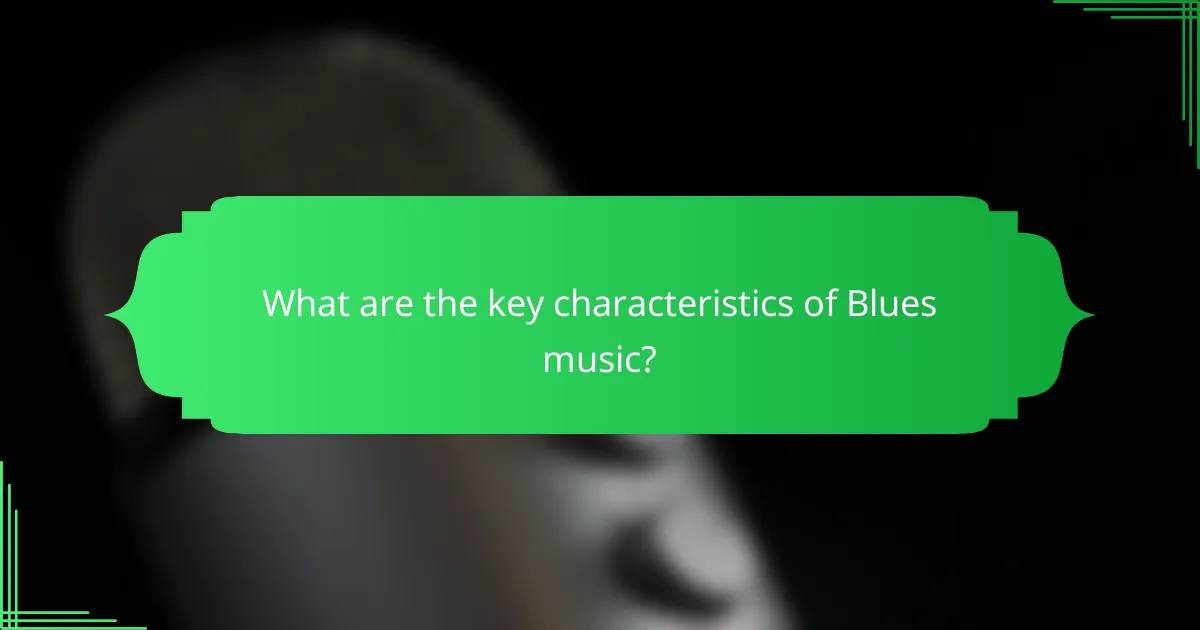The Blues is a powerful musical genre that conveys deep emotions through its rich storytelling and improvisational techniques. Originating from the African American experience in the late 19th and early 20th centuries, it blends elements of work songs and spirituals to reflect the complexities of human feelings. Essential guitar techniques such as bending notes and slide guitar play a crucial role in enhancing the emotional depth and distinctive sound of this timeless music style.

How does the Blues express emotions?
The Blues expresses emotions through its deep-rooted storytelling, melancholic themes, and improvisational techniques. This genre captures the essence of human experience, allowing artists to convey feelings of sorrow, joy, and resilience.
Raw emotional storytelling
Blues music is characterized by its narrative style, often recounting personal experiences and struggles. Artists use lyrics to tell stories that resonate with listeners, creating a connection through shared emotions. For example, classic blues songs frequently address themes of heartbreak, loss, and hardship.
Storytelling in the Blues often employs a call-and-response format, where the singer’s lines are echoed or answered by the guitar. This interaction enhances the emotional impact, allowing musicians to express their feelings more vividly.
Use of melancholy themes
Melancholy is a central theme in Blues music, reflecting the genre’s origins in African American history and culture. Songs often explore feelings of sadness, longing, and nostalgia, which resonate with listeners on a profound level. The use of minor keys and slow tempos further amplifies these emotions.
Common lyrical motifs include lost love, economic struggles, and existential despair. These themes not only highlight personal pain but also serve as a commentary on broader social issues, making the Blues a powerful vehicle for emotional expression.
Improvisation as emotional release
Improvisation is a key element in Blues, allowing musicians to express their emotions spontaneously. This technique enables artists to adapt their performances based on their feelings in the moment, creating a unique experience for both the performer and the audience. Guitar solos often showcase this emotional release, with players bending notes and using expressive techniques like slides and vibrato.
Improvisation in the Blues encourages creativity and personal expression, making each performance distinct. Musicians often draw from their emotional state, leading to powerful and moving interpretations that resonate deeply with listeners.

What guitar techniques are essential in Blues?
Essential guitar techniques in Blues include bending notes, slide guitar, and fingerpicking patterns. Mastering these techniques enhances emotional expression and contributes to the genre’s distinctive sound.
Bending notes for expression
Bending notes is a crucial technique in Blues that allows guitarists to add emotional depth to their playing. By pushing or pulling the string while fretting, musicians can create a pitch that conveys feelings ranging from sorrow to joy.
To practice bending, start with a target note and aim to reach a half-step or whole-step higher pitch. Use your ring finger to bend the string while supporting it with your index and middle fingers for stability. Common bends occur on the 2nd and 3rd strings, often in the pentatonic scale.
Slide guitar for soulful sound
Slide guitar is another hallmark of Blues music, characterized by the use of a slide (often made of glass or metal) to glide along the strings. This technique produces a smooth, expressive sound that can mimic the human voice.
To play slide guitar, ensure your slide is positioned directly over the fret rather than pressing down on the string. Practice playing single notes and chords while maintaining a steady hand to achieve a clean sound. Experiment with different slide materials to find the tone that suits your style.
Fingerpicking patterns
Fingerpicking patterns are essential for creating intricate rhythms and melodies in Blues. This technique involves plucking the strings with individual fingers instead of using a pick, allowing for more nuanced expression.
Start with basic patterns, such as alternating bass notes with melody lines. A common approach is to use your thumb for bass notes and your index and middle fingers for higher strings. As you gain confidence, incorporate more complex patterns and syncopation to enhance your playing.

What are the historical roots of Blues music?
The historical roots of Blues music lie in the African American experience, particularly in the late 19th and early 20th centuries. It emerged from a blend of African musical traditions, work songs, and spirituals, reflecting the struggles and emotions of its creators.
Origins in African American communities
Blues music originated in the African American communities of the Southern United States, particularly in areas like Louisiana and Mississippi. It served as a form of expression for the hardships faced by African Americans, including slavery and segregation.
These communities utilized storytelling through music, often incorporating personal and communal experiences into their songs. This practice helped to preserve cultural identity and foster a sense of belonging.
Influence of work songs and spirituals
Work songs and spirituals significantly influenced the development of Blues music. Work songs, sung by laborers in fields and factories, often featured call-and-response patterns that became a hallmark of Blues.
Spirituals, on the other hand, conveyed deep emotional and religious sentiments, which were woven into the fabric of Blues. This blending of secular and sacred themes created a rich emotional landscape that resonates in Blues music today.
Development in the Mississippi Delta
The Mississippi Delta is often regarded as the birthplace of the Blues, where the genre matured in the early 20th century. Musicians like Robert Johnson and Muddy Waters emerged from this region, bringing unique guitar techniques and vocal styles that defined the genre.
The Delta Blues style is characterized by its use of slide guitar and expressive lyrics, often reflecting themes of love, loss, and hardship. This development laid the groundwork for later styles of Blues and influenced numerous other music genres, such as rock and roll and jazz.

How has Blues influenced modern music in Canada?
The Blues has significantly shaped modern music in Canada, impacting various genres and inspiring countless artists. Its emotional depth and distinctive guitar techniques have permeated rock, jazz, and folk, creating a rich musical landscape.
Impact on rock and roll
The influence of Blues on rock and roll in Canada is profound, with many Canadian rock bands drawing from its emotional expression and guitar-driven sound. Artists like The Tragically Hip and Rush have incorporated Blues elements, blending them with rock to create a unique sound that resonates with audiences.
Key characteristics of Blues, such as the twelve-bar structure and expressive guitar solos, have become staples in rock music. This fusion has led to the emergence of subgenres like Canadian rock, which often features Blues-inspired riffs and lyrical themes.
Integration into jazz and folk
Blues has also found a home in Canadian jazz and folk music, where its improvisational elements and storytelling traditions enhance these genres. Many Canadian jazz musicians, such as Oscar Peterson, have integrated Blues techniques into their performances, enriching the jazz landscape with emotional depth.
In folk music, artists like Bruce Cockburn and Loreena McKennitt have incorporated Blues influences into their songwriting, creating a fusion that reflects both cultural heritage and personal experiences. This blending of styles showcases the versatility of Blues and its ability to adapt across genres.
Canadian Blues artists’ contributions
Canadian Blues artists have made significant contributions to the genre, helping to shape its evolution both locally and internationally. Musicians like Colin James and Sue Foley have gained recognition for their mastery of Blues guitar and heartfelt performances, bringing Canadian Blues to a wider audience.
Festivals such as the Toronto Blues Festival and the Montreal International Jazz Festival celebrate these artists and their influence, providing platforms for emerging talent. These events highlight the vibrant Blues scene in Canada, fostering a community that continues to innovate and inspire.

What are the key characteristics of Blues music?
Blues music is characterized by its emotional depth, distinct musical structure, and expressive guitar techniques. It often conveys feelings of sorrow, longing, and resilience through its unique elements.
12-bar structure
The 12-bar structure is a foundational element of Blues music, providing a simple yet effective framework for composition. This format typically consists of three lines of four bars each, often following a specific chord progression, such as the I-IV-V pattern. Musicians can easily adapt this structure for improvisation, making it a staple in live performances.
For example, in the key of E, the chords would be E (I), A (IV), and B (V). This predictable pattern allows both musicians and audiences to engage deeply with the music, fostering a sense of familiarity and connection.
Call and response patterns
Call and response is a technique where one musical phrase (the call) is answered by another phrase (the response), creating a conversational dynamic. This pattern is rooted in African musical traditions and is prevalent in Blues, enhancing the emotional expression of the genre. It often involves vocals interacting with instruments, such as a singer’s line being echoed by a guitar riff.
For instance, a singer might deliver a line expressing heartache, followed by a guitar playing a complementary melody that reflects that emotion. This interplay not only enriches the musical experience but also invites audience participation, making it a lively aspect of Blues performances.
Use of blue notes
Blue notes are specific notes that are played at a slightly lower pitch than the standard scale, adding a unique emotional quality to Blues music. Typically, these notes are the third, fifth, and seventh degrees of the scale, which are flattened to evoke feelings of sadness or longing. This technique is essential for creating the distinctive sound that defines the genre.
For example, in the key of C, the blue notes would be E (flattened third), G (flattened fifth), and B (flattened seventh). Musicians often use these notes in solos and melodies to convey deep emotional content, making the music resonate with listeners on a personal level.

What are the common themes in Blues lyrics?
Blues lyrics often explore deep emotional experiences, reflecting themes such as love, hardship, and social issues. These themes resonate with listeners, providing a powerful outlet for expression and connection.
Love and heartbreak
Love and heartbreak are central themes in Blues music, capturing the pain and joy of romantic relationships. Many songs express feelings of longing, betrayal, and loss, often using vivid imagery to convey emotional depth.
For example, a common narrative might involve a lover leaving, leading to feelings of sorrow and regret. This theme allows artists to connect with listeners who have experienced similar heartaches, making the music relatable and poignant.
Poverty and hardship
Poverty and hardship are prevalent in Blues lyrics, reflecting the struggles faced by many in society. Artists often draw from personal experiences of economic difficulties, unemployment, and the daily grind of life.
These themes highlight resilience in the face of adversity, with songs frequently portraying a sense of hope despite challenging circumstances. The use of storytelling in this context helps to humanize the struggles, allowing listeners to empathize with the artist’s plight.
Social and political commentary
Blues music also serves as a platform for social and political commentary, addressing issues such as racism, inequality, and injustice. Many artists use their lyrics to speak out against societal problems, reflecting the realities of their communities.
This theme not only raises awareness but also fosters a sense of solidarity among listeners. By addressing these critical issues, Blues music becomes a powerful vehicle for change and reflection, encouraging dialogue around important topics.
